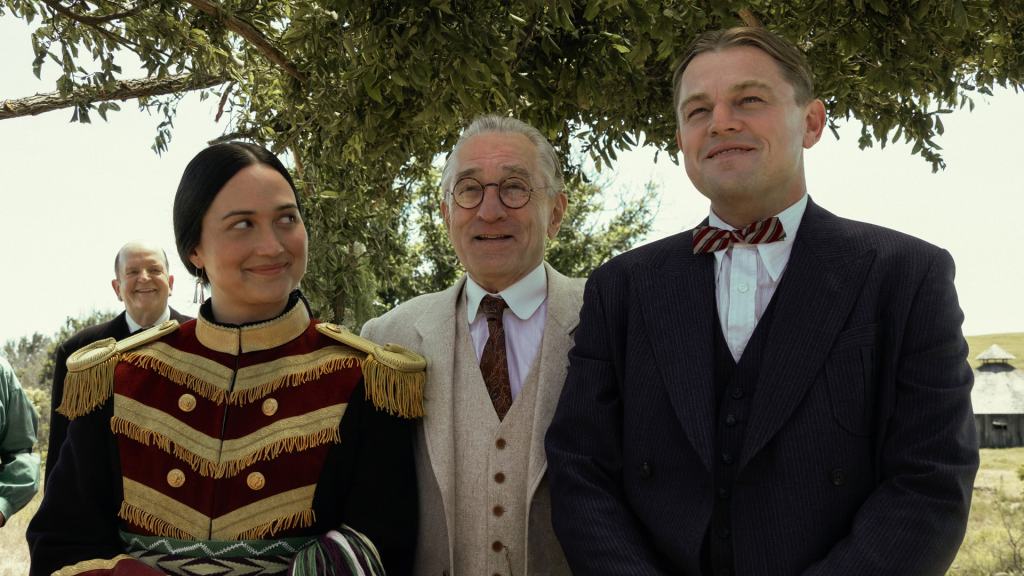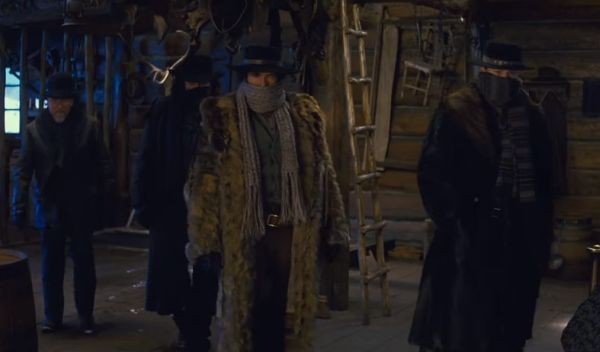
Killers Of The Flower Moon is a film of a crime story we often forget. It’s one we need to be reminded of, especially because of the times we live in.
Let’s face it. American Fiction may show how bad the entertainment industry is at dealing with entertainment featuring African Americans. How easily we forget Hollywood has also had a terrible history in it’s depictions of Native Americans. I’m sure those “Cowboys And Indians” movies come to mind, and boy did they age badly! The depictions of Native Americans have been better over the years, but imperfect. Sure, we have Dances With Wolves, but stereotypes are still present in a lot of entertainment or Indigenous actors lack presence and proper depiction in films.
As bad as the depiction of Native Americans are in Hollywood films, it’s nothing compared to the treatment of Native Americans in its centuries of history. We’ve all learned the history. The influx of settlers and the ruling colonialists throwing them off their land, the various “Indian Wars,” the reservations created, their own Residential School system, it’s a sorry history. Sure makes those games of “cowboys and indians” you used to play an embarrassing memory, doesn’t it? Here, we have an incident that has gone forgotten over the years: The Osage Murders that happened almost a full century ago.
We see the story. The indigenous are forced off their land into anywhere. The Osage were one such people lucky to find their own wealth through natural resources. Soon, the Indigenous of Osage were wealthier than the white people. However court orders white guardians to guard their wealth. One man enters the community and plays an elder to get the wealth. His nephew even falls in love with an Osage woman he’s the driver of and eventually marries her. Then the crime happens,. Many Osage in the town are killed, including three of the women’s sisters. Even the nephew is prompted to give his wife insulin poisoned with heroin and she nearly dies. As she recovers truths are unraveled and soon the elder and his sheepish nephew face the music for what they’ve done.
This story’s presentation of the murders and the crime can be seen through many angles. The thing about the film is that it not only focuses on the murders but it also focuses on the greedy white men, most notably William Hale, who sought to take that very wealth. Over time, crime comes to the town of Fairfax, Oklahoma with murders coming with the greed. Sounds like your common mob story, but that’s what it became. A story of a white mob killing the Indigenous people for their riches. As much as this is about rich Indigenous people being killed in the name of greed, it also comes across as an unnoticed “Indian War.” You’ve heard the history. Hundreds of Indian wars between white settlers and the Indigenous peoples. The war ends with many of the Indigenous killed and they’re forced off their land. In this story’s case, it appears as a war over the riches and who should have control. Once again, white people feeling they should be calling the shots. And in the state of Oklahoma in the 1920’s. The Osage had many signs sensing something would be wrong. From white people showing up in their towns to the alert they received from the 1921 Tulsa race riots to marching in a parade along with the Ku Klux Klan just behind them. A lot of signals. And with these murders happening around the time the FBI was being formed, the film succeeds in making this incident look like the incident that pioneered the FBI to be instituted.
Even with this being a crime story, it’s also a love story of a love that blossomed and died because of this. Ernest Burkhart drives Molly and falls in love with her. The love appears genuine between the two. They marry with Hale’s blessing and form a family. Then tragedy comes with many of Mollie’ sisters and her family dying ugly brutal deaths. Meanwhile Ernest is constantly under Hale’s thumb. He’s constantly torn between the love of Mollie and his loyalty to following Hale’s orders, including his order to give Molly insulin laced with heroin. Mollie would have been the last of her sisters to die, but she survived. Over time, secrets unravel. That last scene between Ernest and Mollie narrowed the story down. What should have been love between the two became betrayal and near-murder.
This is another good achievement from Martin Scorsese. In all of his sixty-five years in film making, Scorsese isn’t afraid to dive into new territory or try new things. This film he directed and co-wrote with Eric Roth is a telling story of the incidents that happened and how it affected a peoples. It shows how a story of a crime committed in the name of greed from almost a full century ago is a case of the systemic racism many Americans believe to be the right thing and insist on having.
There are some Indigenous film critics that feel this story could have been done better if written by an Indigenous writer. I do agree an Indigenous scriptwriter would have done a better job of telling this story from the side of the Indigenous people. Nevertheless, this is a crime story. If you’ve seen Scorsese’s past works, it seems as though Scorsese is the master of crime dramas. He does an excellent job of showing the crime that happened and the greed that fueled it. He also succeeds in showing the Indigenous people in a dignified manner and stays away from the common cliches white writers normally give Indigenous stories. Even the ending as the present-day Osage people are shown celebrating themselves is a big change of pace and worthy of admiration.
The acting of Leonardo Di Caprio as Ernest is good, but this is not his best effort. I’ve seen better acting from him before. Nevertheless he does succeed in making you question the history. Did Ernest truly lover Mollie? Or did he marry her to get her riches at the cost of her life? Ernest did have involvement with murdering her sisters and their families, but did he want to intentionally kill Mollie with her laced insulin? Di Caprio’s acting will make you question. Of all the acting, the standout is the performance of Lily Gladstone. She succeeds in making it look more like Mollie’s the film’s protagonist as Mollie’s the one caught in the middle. Lily does an excellent job of acting without overacting. Her performance really tells a lot of the story of a women going from being in love to going through unimaginable tragedy to almost being a victim herself to herself achieving her own independence. She’s also good at conveying despite braking free, there’s still the hurt of betrayal left behind. Also excellent is Robert de Niro as William Hale. Having worked with Scorsese many times, de Niro does a good job of showcasing Hale as the community “elder” who’s a crime boss when people aren’t looking. That’s something common in mob stories, but de Niro succeeds in making Hale look like exactly that.
Additional good acting performances come from Cara Jade Myers for her performance of the rebellious Anna Kyle, Jesse Plemons as investigator Thomas Bruce White, and Tantoo Cardinal as the grieving and sick mother Lizzie Q. Rodrigo Prieto does a great job with the cinematography. Thelma Schoonmaker does a great job with the editing, but it does leave you questioning whether the film should be 3.5 hours long. The production design is excellent in recreating 1920’s Fairfax. Jacqueline West does a great job in costume design in accurately recreating the Indigenous costumes flawlessly. Finally the score and music composed by the late Robbie Robertson add to the drama of the story and the triumph at the end.
Killers Of The Flower Moon is a great story showing how a crime spree is very reflective of systemic racism. It also does a great job not only recreating the story, but showcasing the people that were in the middle of it, both perpetrators and victims.


